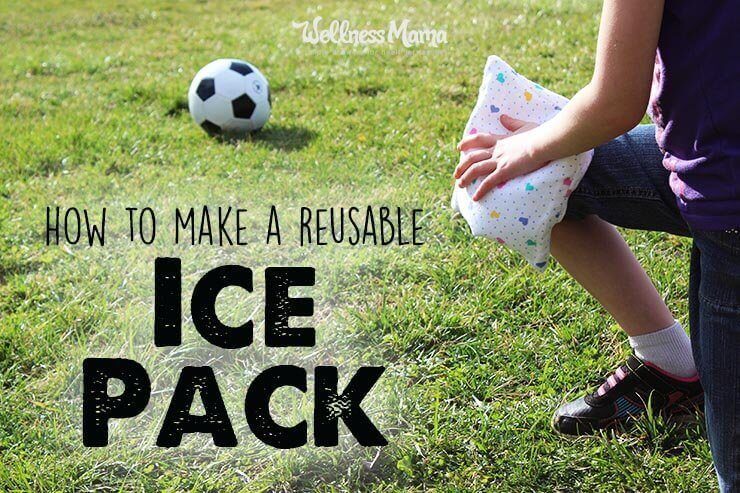Aches and pains happen, and when they do, it is handy to have flexible ice packs in your freezer ready to go. In my house, they are frequently used for “boo-boos” but inevitably, the store-bought ones all begin to leak.
Frozen vegetables work for a time or two but after a couple of uses they become a solid block of ice that is no longer flexible or easy to use. Ice cubes can work in a pinch but they also make a wet mess as they melt quickly and cannot be reused.
DIY Reusable Flexible Ice Pack
I discovered how easy and inexpensive it is to make my own ice packs and I can bag them in such a way that they will not leak. I also love how easy it is to make them in many different shapes and sizes for specific uses.
As a bonus, you can toss one of these into your lunch bag to keep your food cool while you are at work or the park. The best part? You’ll only need a few ingredients to make these simple ice packs and one simple ingredient keeps the ice packs flexible:
How To Make A Flexible Ice Pack
The key to making an ice pack that stays flexible is alcohol. Rubbing alcohol has a freezing point between -26 and -58 degrees F, depending on the percentage of isopropyl alcohol to water, making it virtually impossible to freeze in a home freezer. When it is combined with water that will freeze at 32 degrees F, the result is a slushy, partially frozen mixture that can be frozen and reused again and again.
I use a 2-1 ratio of water to rubbing alcohol. You can adjust the ratio to suit your needs. More alcohol will make the ice pack slushier. Less alcohol will make it firmer.
Ice Pack Supplies
- Rubbing alcohol (I used a 70% isopropyl rubbing alcohol)
- water
- 2 1-quart freezer bags (use a trusted brand to prevent leaks- or use these heavier duty and safer plastic bags for really long-term use)
- Optional: vacuum sealer and bags for leak-proof seal (or duct tape to ensure edges stay sealed)
Ice Pack Instructions
- Measure 1 cup alcohol and 2 cups water into a freezer bag
- Remove as much air as possible and seal
- Place bag with mixture into the second bag by inserting it zipper side first
- Remove as much air as possible and seal
- Freeze and use as needed
For vacuum bag option: after step 2, place your bag with mixture into a vacuum bag that has been cut to the appropriate size. Follow the directions for your vacuum sealer and seal the bag. This is the best way for preventing leaks and is recommended if kids will be using them.
Experiment with different sized bags for different uses. Try using larger bags for back pain and smaller bags for lunch boxes.
This ice pack is very cold so remember to place a cloth barrier between it and your skin. I have included directions to make a simple removable (and therefore washable) cover that can be used for this purpose.
Removable Cover
I used a scrap of flannel I had laying around the house. There is minimal sewing required to complete this cover. For the sake of explanation I will use my actual measurements. Yours may vary.
- Measure the width and length of your finished ice pack. Mine was 8″x 8″. Add 1 inch to each measurement
- Cut 1 piece measuring 9″x 9″
- For the second piece, using the dimensions of your ice pack (8″x 8″), add 1″ to the length and 2″ to the width
- Cut 1 piece measuring 9″x 10″
- Cut the width of the second piece in half so that you will end up with 2 pieces measuring 9″x 5″
- Sew a narrow hem (approx. 1/4″) along each 9″ edge where you cut the piece in half. Do not hem the outer edges
- Lay the half pieces on top of the first piece with right sides together so that the hemmed edges slightly overlap in the center
- Pin around the edges to hold the pieces together
- Sew a 1/2″ seam around the outside edge
- Flip the cover right-side-out and insert the ice pack like you would a pillow into a pillow sham
A Reusable Pre-Made Ice Pack
If you don’t want to make your own from scratch or if you want to avoid plastic bags, consider making a fully reusable version by mixing the same ratio of water and rubbing alcohol in an ice bag like this one. Just keep in the freezer, and you’ll always have an ice pack on hand without the need to change out the ice inside the bag each time you use it.
This is still a much more cost effective option, and it takes only seconds to make. Not only is the water/alcohol ice mixture inside reusable, but the materials cost much less than store bought ice packs. The last store bought ice pack I purchased cost just over $13, and all of the supplies for this ice-bag version cost about $7 total.
I’ve also found that these homemade versions are much more effective since they can be customized for desired firmness and coolness.
Have you ever made your own flexible ice packs?




Leave a Reply